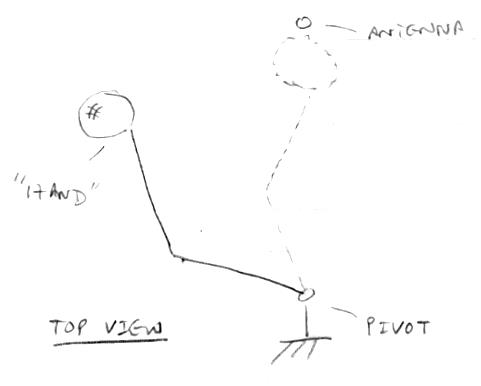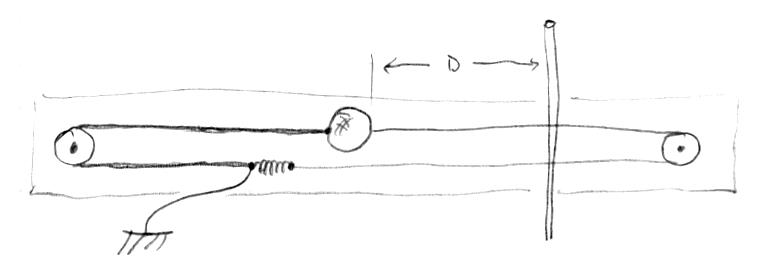Standartization of linearity measurements
ILYA, for the "hand" paddle, I would use a roughly hand sized sphere instead of a plate. This would simplify and make much clearer the distance measurement between it and the pitch antenna (the distance between the closest points of both). I would also make the "arm" section long enough and maybe angle it (with a fixed angle) so that it could be located significantly behind the "hand" sphere for all measurements:

Putting the hand sphere on a string and pulley structure would probably give more accurate results:

That's a wire instead of a string on the left for grounding, and a spring between the wire and the string for tension. Mount the whole thing on a plastic holder of some sort (not wood because it has to be near the antenna). Make it long enough so that the spring always remains significantly behind the ball.
Or stick a really lightweight ball (xmas tree ornament, or Styrofoam covered in AL foil) on the end of a telescoping antenna and position it horizontally, which would be much more compact and portable.
It's not a real arm/hand or anything, but I think you would get fewer people arguing with you with this arrangement. And you could always make a simple LC oscillator and calibrate the capacitance of the setup, and compare the results to my real and simulated arm/hand measurements to give confidence in the results.
ILYA this is a good conversation, there are so few of us active members left for technical discussions.
Valery here is some of my Alchemy.
In my early research all of my theremin’s, solid state or vacuum tube, had what seemed to me to be perfect linearity throughout the pitch field right up next to the antenna. The first time I experienced non-linearity is when I purchased a used EtherWave Standard that needed tuning, then it also was quite good.
I have always used Hartley Oscillators operating at 922 kHz and no antenna coils.
Once I thought it was my coiled spring antenna giving me the good results but today I think linearity improves the higher we go in RF frequency.
Another thing I noticed was un-grounding the theremin compressed the pitch field but it was still linear, this did add some RF wave shape distortion. This is one of the phenomena’s that I do not think can be spotted in Computer Modeling.
This might be a useful effect to use controlled grounding so at higher audio frequencies auto-expand the pitch field using frequency to voltage conversion or pwm.
Smaller tank capacitors definitely improved the sensitivity to hand capacitance, the frequency not so much.
It is all madness
Christopher
"Interesting string kinematics, dewster, but a bit more complicated." - ILYA
I can't take credit for it, years ago another TW member was doing a very similar experiment with a coke can on a string. I urged that member to track things back to absolute capacitance, as going by the heterodyned result gave pretty vague results that needed to be repeated many, many times, and measurements like this can be painful to repeat. Though automating them would certainly help some.
What is the ultimate goal of these experiments? To characterize linearity? For any Theremin, but particularly for the EW, you will probably end up with a family of data sets for various settings showing different responses post-heterodyning, which could be useful for understanding the advantages and disadvantages of the EQ coil designs vs. simpler designs, something I've never gotten around to.
"... today I think linearity improves the higher we go in RF frequency ... Smaller tank capacitors definitely improved the sensitivity to hand capacitance, the frequency not so much." - Christopher
I should do more experimenting to nail this down in reality, but I believe higher frequency non-EQ coil Theremins should have somewhat larger tank capacitance (relative to coil inductance) than lower frequency non-EQ coil Theremins, though it doesn't simply scale because tank C alters both absolute sensitivity and operating frequency simultaneously. Every time I see a non-EQ coil low frequency Theremin with huge tank C I have to scratch my head wondering what the designer was thinking. Relative (i.e. musical) sensitivity is fairly fixed for any non-EQ coil Theremin regardless of frequency (tank C merely transposes it), and linearity should also be largely the same once adjusted. I think what you are seeing Christopher is your own designs which probably have the proper tank capacitance, and many poor designs out there which don't. Longer & thinner antennas can help here too.
The largely fixed sensitivity of all analog Theremins was a surprise for me. IMO they are all too sensitive to play easily. The cramped octaves lead to intricate finger gestures and stock-still frozen stances. I believe I want at most 2 octaves over 1/2 meter or so, but this is something to play with once the prototype is up and running. Too bad the Theremini isn't more linear (it's a dog when it comes to linearity) as note spacing is adjustable on it.
dewster this might be the TW thread you were talking about, it is where Greg is studing my Lev Antenna approach. Something interesting was happening and he was operating at the higher RF frequency.
The pitch field as a standard should be viewed as 45 cm or 18" ?
I had another experiment where I was using a 6" antenna wire and it also had wide perfect linearity. I mentioned it at TW but can't find any info right now. It used an unusual rewire of my 900 khz oscillators IF transformers which leads me to believe that the coupling of the two RF oscillators might also play into linearity, more so than antenna length.
In a linear pitch field it may be the higher voltage at the antenna that gives you more linear octaves, if you have three or seven all are still linear.
There is no almost linear in my experiments. It is or isn't, no almost. The linear phenomenon just locks on?
The pitch knob would change the octave widths but not change the linearity.
I am throwing out observations, interpret them as anyone wants.
Here is a sound sample from back in the day demonstrating that with linearity the same finger movements pop the correct musical notes anywhere in the pitch field.
The musical scale relationship with the theremin is something else that I don't think can be modeled, mathematically it almost seems miraculous. Why can the theremin match the distance of the piano key spacing note for note, are the progression of musical notes linear or is it something more human?
I have a 4-layer pcb to stuff today. It is complicated so failure is an option or magic. ![]()
Christopher
Edit: Greg had bad house earth grounding which will shift the pitch field expansion, his results may be better than demonstrated. FredM is not far away, I still hear him. ![]()
You must be logged in to post a reply. Please log in or register for a new account.

